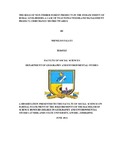Please use this identifier to cite or link to this item:
https://cris.library.msu.ac.zw//handle/11408/369Full metadata record
| DC Field | Value | Language |
|---|---|---|
| dc.contributor.author | Menelisi, Falayi | - |
| dc.date.accessioned | 2014-08-27T15:31:05Z | - |
| dc.date.available | 2014-08-27T15:31:05Z | - |
| dc.date.issued | 2014 | - |
| dc.identifier.uri | http://hdl.handle.net/11408/369 | - |
| dc.description.abstract | The extensive use of biological products from forests has become common in providing critical sources of medicine, food, and fodder and cash income, making dry forests the largest natural supermarket for millions of people in sub Saharan Africa. The study examined the role of Non-Timber Forest Products in the enhancement of rural livelihoods in ward 8 of Chirumanzu District. The study identified and evaluated the role of NTFPs using quantitave and qualitative approaches. Data was acquired through the use of questionnaires, interviews, observations and secondary sources of data. The researcher then used Statistical Package for Social Sciences (SPSS) to evaluate data. The study results confirmed that the households harvested four categories of NTFPs that include foods, medicinal plants, leafy vegetables and construction materials. Biological products harvested played a pivotal role in the enhancement of rural livelihoods by providing sustainable diets, ethno pharmaceutical uses and ethno veterinary uses. Ethno pharmaceutical uses included the utilisation of Aloe Vera (Zumbani) as a mosquito repellent and Ximenia (mutsvanzvabere) is used for treating livestock ringworms. The researcher observed that each household harvested an average yield of 300kgs of Vitex Payos (tsvubvu), 500kgs of Miombo leaf litter (murakwani) and 400 kgs of thatch grass. Commercialization of NTFPs also enhanced household incomes of US$545 per season which was above the poverty datum line of a family of 5. The researcher found out that the indigenous fruits provided more nutritional benefits than exotic fruits and are important in poverty alleviation for example Strychinos spinosa (matamba) has a K content of 1370d whilst most exotic fruits like oranges have a Kcal content of 400d. This proves that some indigenous fruit trees are more nutritional than exotic trees. The respondents are highly dependent on Miombo leafy litter because of limited access to inorganic fertiliser. This study recommends that Chirumanzu Rural District Council (RDC) should maintain and upgrade the communication infrastructure to enhance NTFPs market base through accessible road networks.Overally, the research findings concluded that NTFPs are pivotal for the enhancement of rural livelihoods. | en_US |
| dc.language.iso | en | en_US |
| dc.publisher | Midlands State University | en_US |
| dc.subject | Rural livelihoods | en_US |
| dc.subject | Biological products, forests | en_US |
| dc.title | The role of non-timber forest products in the enhancement of rural livelihoods: a case of Nyautongi woodland management project in ward 8 of Chirumanzu District | en_US |
| item.fulltext | With Fulltext | - |
| item.grantfulltext | open | - |
| item.languageiso639-1 | en | - |
| Appears in Collections: | Bsc Geography And Environmental Studies Honours Degree | |
Files in This Item:
| File | Description | Size | Format | |
|---|---|---|---|---|
| Final dissertation DOCUMENT.pdf | 6.96 MB | Adobe PDF |  View/Open |
Page view(s)
140
checked on Nov 23, 2025
Download(s)
450
checked on Nov 23, 2025
Google ScholarTM
Check
Items in MSUIR are protected by copyright, with all rights reserved, unless otherwise indicated.



